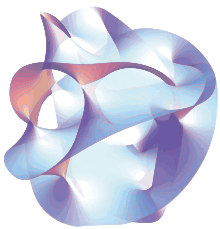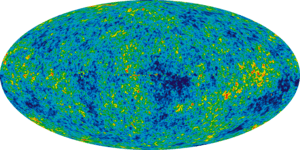Brane cosmology
Brane cosmology refers to several theories in particle physics and cosmology related to string theory, superstring theory and M-theory.
| String theory |
|---|
 |
| Fundamental objects |
| Perturbative theory |
| Non-perturbative results |
| Phenomenology |
| Mathematics |
|
Theorists
|
| Part of a series on | ||||
| Physical cosmology | ||||
|---|---|---|---|---|
 | ||||
|
Early universe
|
||||
|
Expansion · Future |
||||
|
Components · Structure
|
||||
| ||||
Brane and bulk
The central idea is that the visible, three-dimensional universe is restricted to a brane inside a higher-dimensional space, called the "bulk" (also known as "hyperspace"). If the additional dimensions are compact, then the observed universe contains the extra dimension, and then no reference to the bulk is appropriate. In the bulk model, at least some of the extra dimensions are extensive (possibly infinite), and other branes may be moving through this bulk. Interactions with the bulk, and possibly with other branes, can influence our brane and thus introduce effects not seen in more standard cosmological models.
Why gravity is weak and the cosmological constant is small
Some versions of brane cosmology, based on the large extra dimension idea, can explain the weakness of gravity relative to the other fundamental forces of nature, thus solving the hierarchy problem. In the brane picture, the electromagnetic, weak and strong nuclear force are localized on the brane, but gravity has no such constraint and propagates on the full spacetime, called bulk. Much of the gravitational attractive power "leaks" into the bulk. As a consequence, the force of gravity should appear significantly stronger on small (subatomic or at least sub-millimetre) scales, where less gravitational force has "leaked". Various experiments are currently under way to test this.[1] Extensions of the large extra dimension idea with supersymmetry in the bulk appears to be promising in addressing the so-called cosmological constant problem.[2][3][4]
Models of brane cosmology
One of the earliest documented attempts to apply brane cosmology as part of a conceptual theory is dated to 1983.[5]
The authors discussed the possibility that the Universe has dimensions, but ordinary particles are confined in a potential well which is narrow along spatial directions and flat along three others, and proposed a particular five-dimensional model.
In 1998/99 Merab Gogberashvili published on arXiv a number of articles where he showed that if the Universe is considered as a thin shell (a mathematical synonym for "brane") expanding in 5-dimensional space then there is a possibility to obtain one scale for particle theory corresponding to the 5-dimensional cosmological constant and Universe thickness, and thus to solve the hierarchy problem.[6][7] Gogberashvili also showed that the four-dimensionality of the Universe is the result of the stability requirement found in mathematics since the extra component of the Einstein field equations giving the confined solution for matter fields coincides with one of the conditions of stability.[8]
In 1999 there were proposed the closely related Randall–Sundrum scenarios, RS1 and RS2. (See Randall–Sundrum model for a nontechnical explanation of RS1). These particular models of brane cosmology have attracted a considerable amount of attention. For instance, the related Chung-Freeze model, which has applications for spacetime metric engineering, followed in 2000.[9]
Later, the pre-big bang, ekpyrotic and cyclic proposals appeared. The ekpyrotic theory hypothesizes that the origin of the observable universe occurred when two parallel branes collided.[10]
Empirical tests
As of now, no experimental or observational evidence of large extra dimensions, as required by the Randall–Sundrum models, has been reported. An analysis of results from the Large Hadron Collider in December 2010 severely constrains the black holes produced in theories with large extra dimensions.[11] The recent multi-messenger gravitational wave event GW170817 has also been used to put weak limits on large extra dimensions.[12][13]
References
- Session D9 - Experimental Tests of Short Range Gravitation.
- Y. Aghababaie; C.P. Burgess; S.L. Parameswaran; F. Quevedo (March 2004). "Towards a naturally small cosmological constant from branes in 6-D supergravity". Nucl. Phys. B. 680 (1–3): 389–414. arXiv:hep-th/0304256. Bibcode:2004NuPhB.680..389A. doi:10.1016/j.nuclphysb.2003.12.015. S2CID 14612396.
- C.P. Burgess; Leo van Nierop (March 2013). "Technically Natural Cosmological Constant From Supersymmetric 6D Brane Backreaction". Phys. Dark Univ. 2 (1): 1–16. arXiv:1108.0345. Bibcode:2013PDU.....2....1B. doi:10.1016/j.dark.2012.10.001. S2CID 92984489.
- C. P. Burgess; L. van Nierop; S. Parameswaran; A. Salvio; M. Williams (February 2013). "Accidental SUSY: Enhanced Bulk Supersymmetry from Brane Back-reaction". JHEP. 2013 (2): 120. arXiv:1210.5405. Bibcode:2013JHEP...02..120B. doi:10.1007/JHEP02(2013)120. S2CID 53667729.
- Rubakov, V. A.; Shaposhnikov, M. E. (1983). "Do we live inside a domain wall?". Physics Letters. B. 125 (2–3): 136–138. Bibcode:1983PhLB..125..136R. doi:10.1016/0370-2693(83)91253-4.
- Gogberashvili, M. (1998). "Hierarchy problem in the shell universe model". International Journal of Modern Physics D. 11 (10): 1635–1638. arXiv:hep-ph/9812296. doi:10.1142/S0218271802002992. S2CID 119339225.
- Gogberashvili, M. (2000). "Our world as an expanding shell". Europhysics Letters. 49 (3): 396–399. arXiv:hep-ph/9812365. Bibcode:2000EL.....49..396G. doi:10.1209/epl/i2000-00162-1. S2CID 38476733.
- Gogberashvili, M. (1999). "Four dimensionality in noncompact Kaluza–Klein model". Modern Physics Letters A. 14 (29): 2025–2031. arXiv:hep-ph/9904383. Bibcode:1999MPLA...14.2025G. doi:10.1142/S021773239900208X. S2CID 16923959.
- Chung, Daniel J. H.; Freese, Katherine (2000-08-25). "Can geodesics in extra dimensions solve the cosmological horizon problem?". Physical Review D. 62 (6): 063513. arXiv:hep-ph/9910235. Bibcode:2000PhRvD..62f3513C. doi:10.1103/physrevd.62.063513. ISSN 0556-2821.
- Musser, George; Minkel, JR (2002-02-11). "A Recycled Universe: Crashing branes and cosmic acceleration may power an infinite cycle in which our universe is but a phase". Scientific American Inc. Retrieved 2008-05-03.
- CMS Collaboration (2011). "Search for Microscopic Black Hole Signatures at the Large Hadron Collider". Physics Letters B. 697 (5): 434–453. arXiv:1012.3375. Bibcode:2011PhLB..697..434C. doi:10.1016/j.physletb.2011.02.032. S2CID 118488193.
- Luca Visinelli; Nadia Bolis; Sunny Vagnozzi (March 2018). "Brane-world extra dimensions in light of GW170817". Phys. Rev. D. 97 (6): 064039. arXiv:1711.06628. Bibcode:2018PhRvD..97f4039V. doi:10.1103/PhysRevD.97.064039. S2CID 88504420.
- Freeland, Emily (2018-09-21). "Hunting for extra dimensions with gravitational waves". The Oskar Klein Centre for Cosmoparticle Physics blog.
External links
- Brax, Philippe; van de Bruck, Carsten (2003). "Cosmology and Brane Worlds: A Review". Classical and Quantum Gravity. 20 (9): R201–R232. arXiv:hep-th/0303095. Bibcode:2003CQGra..20R.201B. doi:10.1088/0264-9381/20/9/202. S2CID 9623407. – Cosmological consequences of the brane world scenario are reviewed in a pedagogical manner.
- Langlois, David (2003). "Brane cosmology: an introduction". Progress of Theoretical Physics Supplement. 148: 181–212. arXiv:hep-th/0209261. Bibcode:2002PThPS.148..181L. doi:10.1143/PTPS.148.181. S2CID 9751130. – These notes (32 pages) give an introductory review on brane cosmology.
- Papantonopoulos, Eleftherios (2002). "Brane Cosmology". Cosmological Crossroads. Lecture Notes in Physics. 592. pp. 458–477. arXiv:hep-th/0202044. Bibcode:2002LNP...592..458P. doi:10.1007/3-540-48025-0_15. ISBN 978-3-540-43778-9. S2CID 3084654. – Lectures (24 pages) presented at the First Aegean Summer School on Cosmology, Samos, September 2001.
- Brane cosmology on arxiv.org
- Dimensional Shortcuts - evidence for sterile neutrino; (August 2007; Scientific American)
